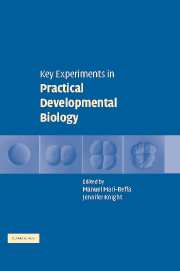Book contents
- Frontmatter
- Contents
- List of contributors
- Preface
- Introduction
- SECTION I GRAFTINGS
- SECTION II SPECIFIC CHEMICAL REAGENTS
- SECTION III BEAD IMPLANTATION
- SECTION IV NUCLEIC ACID INJECTIONS
- SECTION V GENETIC ANALYSIS
- SECTION VI CLONAL ANALYSIS
- SECTION VII IN SITU HYBRIDIZATION
- SECTION VIII TRANSGENIC ORGANISMS
- 19 Bicoid and Dorsal: Two transcriptions factor gradients which specify cell fates in the early Drosophila embryo
- 20 Significance of the temporal modulation of Hox gene expression on segment morphology
- 21 The UAS/GAL4 system for tissue-specific analysis of EGFR gene function in Drosophila melanogaster
- 22 Neurogenesis in Drosophila: A genetic approach
- 23 Role of the achaete-scute complex genes in the development of the adult peripheral nervous system of Drosophila melanogaster
- SECTION IX VERTEBRATE CLONING
- SECTION X CELL CULTURE
- SECTION XI EVO–DEVO STUDIES
- SECTION XII COMPUTATIONAL MODELLING
- Appendix 1 Abbreviations
- Appendix 2 Suppliers
- Index
- Plate Section
- References
23 - Role of the achaete-scute complex genes in the development of the adult peripheral nervous system of Drosophila melanogaster
Published online by Cambridge University Press: 11 August 2009
- Frontmatter
- Contents
- List of contributors
- Preface
- Introduction
- SECTION I GRAFTINGS
- SECTION II SPECIFIC CHEMICAL REAGENTS
- SECTION III BEAD IMPLANTATION
- SECTION IV NUCLEIC ACID INJECTIONS
- SECTION V GENETIC ANALYSIS
- SECTION VI CLONAL ANALYSIS
- SECTION VII IN SITU HYBRIDIZATION
- SECTION VIII TRANSGENIC ORGANISMS
- 19 Bicoid and Dorsal: Two transcriptions factor gradients which specify cell fates in the early Drosophila embryo
- 20 Significance of the temporal modulation of Hox gene expression on segment morphology
- 21 The UAS/GAL4 system for tissue-specific analysis of EGFR gene function in Drosophila melanogaster
- 22 Neurogenesis in Drosophila: A genetic approach
- 23 Role of the achaete-scute complex genes in the development of the adult peripheral nervous system of Drosophila melanogaster
- SECTION IX VERTEBRATE CLONING
- SECTION X CELL CULTURE
- SECTION XI EVO–DEVO STUDIES
- SECTION XII COMPUTATIONAL MODELLING
- Appendix 1 Abbreviations
- Appendix 2 Suppliers
- Index
- Plate Section
- References
Summary
OBJECTIVE OF THE EXPERIMENT Formation of the pattern of external sensory organs (SOs) that cover the adult cuticle of Drosophila melanogaster is controlled by the proneural achaete (ac) and scute (sc) genes of the achaete-scute complex (AS-C) (reviewed in Campuzano and Modolell, 1992; Modolell and Campuzano, 1998). ac and sc encode transcription factors of the basic helix-loop-helix (bHLH) family. Both genes are co-expressed in the imaginal discs (the precursors of the adult epidermis) in a reproducible pattern of clusters of cells (the proneural clusters) from which one cell is determined to become the precursor cell of the SO, the sensillum mother cell (SMC). The objectives of the experiments outlined below are to demonstrate the requirement of the spatially restricted expression of ac/sc for the generation of the wild type pattern of SOs and to analyze the control of ac/sc expression.
DEGREE OF DIFFICULTY The experiments are moderately difficult.
INTRODUCTION
The peripheral nervous system of Drosophila is a very suitable model in which to analyze the genetic control of pattern formation. The cuticle of Drosophila melanogaster contains thousands of external mechano- or chemoreceptor SOs – the bristles or chaetae and other sensilla – which are arranged according to a stereotyped pattern (Figure 23.1a). Each external SO is derived from a single cell, the sensillum mother cell (SMC), which, in general, undergoes two differential divisions.
- Type
- Chapter
- Information
- Key Experiments in Practical Developmental Biology , pp. 296 - 309Publisher: Cambridge University PressPrint publication year: 2005



